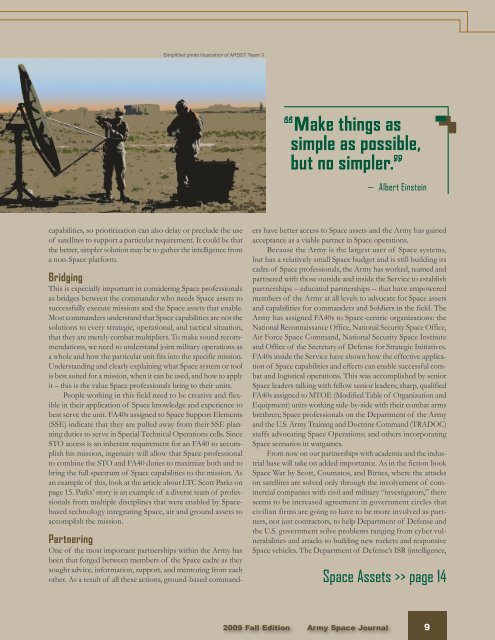Volume 8, Number 3 - Space and Missile Defense Command - U.S. ...
Volume 8, Number 3 - Space and Missile Defense Command - U.S. ...
Volume 8, Number 3 - Space and Missile Defense Command - U.S. ...
Create successful ePaper yourself
Turn your PDF publications into a flip-book with our unique Google optimized e-Paper software.
Simplified photo illustration of ARSST Team 3<br />
Make things as<br />
simple as possible,<br />
but no simpler.<br />
— Albert Einstein<br />
capabilities, so prioritization can also delay or preclude the use<br />
of satellites to support a particular requirement. It could be that<br />
the better, simpler solution may be to gather the intelligence from<br />
a non-<strong>Space</strong> platform.<br />
Bridging<br />
This is especially important in considering <strong>Space</strong> professionals<br />
as bridges between the comm<strong>and</strong>er who needs <strong>Space</strong> assets to<br />
successfully execute missions <strong>and</strong> the <strong>Space</strong> assets that enable.<br />
Most comm<strong>and</strong>ers underst<strong>and</strong> that <strong>Space</strong> capabilities are not the<br />
solutions to every strategic, operational, <strong>and</strong> tactical situation,<br />
that they are merely combat multipliers. To make sound recommendations,<br />
we need to underst<strong>and</strong> joint military operations as<br />
a whole <strong>and</strong> how the particular unit fits into the specific mission.<br />
Underst<strong>and</strong>ing <strong>and</strong> clearly explaining what <strong>Space</strong> system or tool<br />
is best suited for a mission, when it can be used, <strong>and</strong> how to apply<br />
it – this is the value <strong>Space</strong> professionals bring to their units.<br />
People working in this field need to be creative <strong>and</strong> flexible<br />
in their application of <strong>Space</strong> knowledge <strong>and</strong> experience to<br />
best serve the unit. FA40s assigned to <strong>Space</strong> Support Elements<br />
(SSE) indicate that they are pulled away from their SSE planning<br />
duties to serve in Special Technical Operations cells. Since<br />
STO access is an inherent requirement for an FA40 to accomplish<br />
his mission, ingenuity will allow that <strong>Space</strong> professional<br />
to combine the STO <strong>and</strong> FA40 duties to maximize both <strong>and</strong> to<br />
bring the full spectrum of <strong>Space</strong> capabilities to the mission. As<br />
an example of this, look at the article about LTC Scott Parks on<br />
page 15. Parks’ story is an example of a diverse team of professionals<br />
from multiple disciplines that were enabled by <strong>Space</strong>based<br />
technology integrating <strong>Space</strong>, air <strong>and</strong> ground assets to<br />
accomplish the mission.<br />
Partnering<br />
One of the most important partnerships within the Army has<br />
been that forged between members of the <strong>Space</strong> cadre as they<br />
sought advice, information, support, <strong>and</strong> mentoring from each<br />
other. As a result of all these actions, ground-based comm<strong>and</strong>ers<br />
have better access to <strong>Space</strong> assets <strong>and</strong> the Army has gained<br />
acceptance as a viable partner in <strong>Space</strong> operations.<br />
Because the Army is the largest user of <strong>Space</strong> systems,<br />
but has a relatively small <strong>Space</strong> budget <strong>and</strong> is still building its<br />
cadre of <strong>Space</strong> professionals, the Army has worked, teamed <strong>and</strong><br />
partnered with those outside <strong>and</strong> inside the Service to establish<br />
partnerships – educated partnerships – that have empowered<br />
members of the Army at all levels to advocate for <strong>Space</strong> assets<br />
<strong>and</strong> capabilities for comm<strong>and</strong>ers <strong>and</strong> Soldiers in the field. The<br />
Army has assigned FA40s to <strong>Space</strong>-centric organizations: the<br />
National Reconnaissance Office, National Security <strong>Space</strong> Office,<br />
Air Force <strong>Space</strong> Comm<strong>and</strong>, National Security <strong>Space</strong> Institute<br />
<strong>and</strong> Office of the Secretary of <strong>Defense</strong> for Strategic Initiatives.<br />
FA40s inside the Service have shown how the effective application<br />
of <strong>Space</strong> capabilities <strong>and</strong> effects can enable successful combat<br />
<strong>and</strong> logistical operations. This was accomplished by senior<br />
<strong>Space</strong> leaders talking with fellow senior leaders; sharp, qualified<br />
FA40s assigned to MTOE (Modified Table of Organization <strong>and</strong><br />
Equipment) units working side-by-side with their combat arms<br />
brethren; <strong>Space</strong> professionals on the Department of the Army<br />
<strong>and</strong> the U.S. Army Training <strong>and</strong> Doctrine Comm<strong>and</strong> (TRADOC)<br />
staffs advocating <strong>Space</strong> Operations; <strong>and</strong> others incorporating<br />
<strong>Space</strong> scenarios in wargames.<br />
From now on our partnerships with academia <strong>and</strong> the industrial<br />
base will take on added importance. As in the fiction book<br />
<strong>Space</strong> War by Scott, Coumatos, <strong>and</strong> Birnes, where the attacks<br />
on satellites are solved only through the involvement of commercial<br />
companies with civil <strong>and</strong> military “investigators,” there<br />
seems to be increased agreement in government circles that<br />
civilian firms are going to have to be more involved as partners,<br />
not just contractors, to help Department of <strong>Defense</strong> <strong>and</strong><br />
the U.S. government solve problems ranging from cyber vulnerabilities<br />
<strong>and</strong> attacks to building new rockets <strong>and</strong> responsive<br />
<strong>Space</strong> vehicles. The Department of <strong>Defense</strong>’s ISR (intelligence,<br />
<strong>Space</strong> Assets >> page 14<br />
2009 Fall Edition Army <strong>Space</strong> Journal 9
















